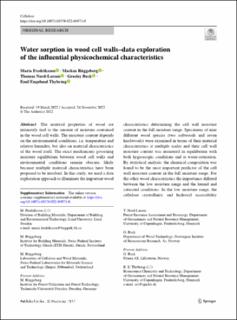| dc.contributor.author | Fredriksson, Maria | |
| dc.contributor.author | Rüggeberg, Markus | |
| dc.contributor.author | Nord-Larsen, Thomas | |
| dc.contributor.author | Beck, Greeley | |
| dc.contributor.author | Thybring, Emil Engelund | |
| dc.date.accessioned | 2023-01-04T13:29:05Z | |
| dc.date.available | 2023-01-04T13:29:05Z | |
| dc.date.created | 2022-12-16T17:04:38Z | |
| dc.date.issued | 2022-12-07 | |
| dc.identifier.citation | Fredriksson, M., Rüggeberg, M., Nord-Larsen, T. et al. Water sorption in wood cell walls–data exploration of the influential physicochemical characteristics. Cellulose (2022) | en_US |
| dc.identifier.issn | 0969-0239 | |
| dc.identifier.uri | https://hdl.handle.net/11250/3040973 | |
| dc.description.abstract | The material properties of wood are intimately tied to the amount of moisture contained in the wood cell walls. The moisture content depends on the environmental conditions, i.e. temperature and relative humidity, but also on material characteristics of the wood itself. The exact mechanisms governing moisture equilibrium between wood cell walls and environmental conditions remain obscure, likely because multiple material characteristics have been proposed to be involved. In this study, we used a data exploration approach to illuminate the important wood characteristics determining the cell wall moisture content in the full moisture range. Specimens of nine different wood species (two softwoods and seven hardwoods) were examined in terms of their material characteristics at multiple scales and their cell wall moisture content was measured in equilibrium with both hygroscopic conditions and at water-saturation. By statistical analysis, the chemical composition was found to be the most important predictor of the cell wall moisture content in the full moisture range. For the other wood characteristics the importance differed between the low moisture range and the humid and saturated conditions. In the low moisture range, the cellulose crystallinity and hydroxyl accessibility were found to be important predictors, while at high moisture contents the microfibril orientation in the S1 and S3 layers of the cell walls was important. Overall, the results highlighted that no single wood characteristic were decisive for the cell wall moisture content, and each of the predictors identified by the analysis had only a small effect in themselves on the cell wall moisture content. Wood characteristics with a major effect on the cell wall moisture content were, therefore, not identified. | en_US |
| dc.description.abstract | Water sorption in wood cell walls–data exploration of the infuential physicochemical characteristics | en_US |
| dc.language.iso | eng | en_US |
| dc.publisher | Springer Nature | en_US |
| dc.rights | Navngivelse 4.0 Internasjonal | * |
| dc.rights.uri | http://creativecommons.org/licenses/by/4.0/deed.no | * |
| dc.title | Water sorption in wood cell walls–data exploration of the infuential physicochemical characteristics | en_US |
| dc.title.alternative | Water sorption in wood cell walls–data exploration of the infuential physicochemical characteristics | en_US |
| dc.type | Peer reviewed | en_US |
| dc.type | Journal article | en_US |
| dc.description.version | publishedVersion | en_US |
| dc.rights.holder | © The Author(s) 2022 | en_US |
| dc.source.pagenumber | 15 | en_US |
| dc.source.journal | Cellulose | en_US |
| dc.identifier.doi | 10.1007/s10570-022-04973-0 | |
| dc.identifier.cristin | 2094602 | |
| cristin.ispublished | true | |
| cristin.fulltext | original | |
| cristin.qualitycode | 1 | |

